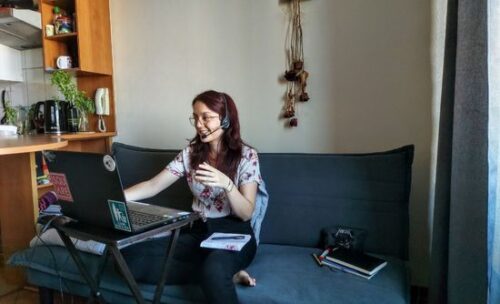Denver, Co – If you work in education, you’re likely immersed in a culture that greatly values continued professional development, or CPD. In recent years, this idea of continuous growth or development has evolved, and a familiar term in the lexicon of the business world has emerged that may better suit the purpose of CPD in the education industry: upskilling. In business, the term upskilling typically describes the process of individuals learning new skills, at least in the micro context. In the macro context, it’s often used to describe a tectonic shift in the workplace, typically in response to technology shifts that impact all aspects of the industry.
Considering the term at both macro and micro levels, upskilling involves a philosophical shift with both individuals and organizations maintaining a lifelong learner mindset that values adaptability, a global perspective, interpersonal skills and of course, continuous competency in evolving technologies and other job-specific content.
The BridgeUniverse article Global, Digital Evolution Drives Need for 21st-Century, Transferable Skills in Today’s Employees explored the evolving 21st-century skills or transferable skills – another business term that has made its way into educational lexicon – that must be taught in today’s classrooms, and many of these same skills are associated with upskilling. At the heart of these initiatives is the focus on developing the lifelong learner mindset. A 2016 joint report by the World Economic Forum and The Boston Consulting Group found that “managing skills in the digital age requires organizations to harness technology that enables them to leverage a data-driven approach to lifelong learning and smart upskilling.”
Teachers are naturally lifelong learners to a great extent, both teaching and learning with their students, but they also work in an industry that is constantly evolving. Teaching practices and methodologies evolve, the English language lexicon itself changes and of course, technologies advance, impacting all aspects of content and delivery in the classroom.

There have always been many types of professional development, both formal and informal. Upskilling is much the same, with techniques ranging from virtual or online courses to in-person courses, from mentoring to shadowing, from after-school, teacher-led training sessions to “lunch and learn” sessions and from micro-learning bite-sized new information to macro-learning completely new skills.
The global shifts driving the need for the teaching of transferable skills in today’s classrooms have not gone unnoticed by governments and other higher-level agencies, and, in recent years, they have been investing in many types of CPD to help teachers meet the evolving needs of their students. And for teachers of English as a second or foreign language, these large-scale shifts are particularly pivotal, as the ELT community is international on a truly global scale, but the community has also historically not had as much access to professional development as most general education teachers, particularly access to training materials specifically targeting second language learning. While we may be seeing an increased investment in teacher training at higher levels, schools must still have the funding to access that CPD. In some parts of the world, this may be the case, but in others, teacher PD consists primarily of attending teacher association events.
In Argentina, for example, English teachers working in the state sector generally take courses offered by state-run CPD centers such as Escuela de Maestros (Teachers School) in Buenos Aires. Courses are free of charge and provide degree credits, as long as the course is assessed and has a duration of 30 hours or is approved by INFoD (Instituto Nacional de Formación Docente or National Institute of Teacher Training).
Some of these teachers are members of English language teachers’ associations, such as APIBA (Asociación de Profesores de Inglés de Buenos Aires or Association of English Teachers of Buenos Aires) for Buenos Aires or FAAPI (Federación Argentina de Asociaciones de Profesores de Inglés or Argentine Federation of Associations of English Teachers) for the whole country, and they attend the CPD courses and conferences offered by the associations, said Silvia Luppi, a graduate English teacher in Chile.
In Argentina, there are also about 200 private schools that are members of ESSARP (English Speaking Scholastic Association of the River Plate) and their teachers attend the courses offered at ESSARP. “The courses aim at developing knowledge and skills of teachers who work at bilingual (Spanish-English) schools in the whole country,” Luppi said.
That said, most English Language Schools in Argentina are run privately and “there is no record of how they plan and implement CPD programs,” she added. “AACI (Asociación Argentina de Clutura Inglesa) includes ‘Capacitación Docente’ [or Teacher Training] on their web page and it is not linked to any other page. Liceo Cultural Británico [British Cultural Lyceum] states they offer CPD programmes to their teachers but there is no information about what kind of courses are offered.”
Luppi pointed out that other organizations such as the British Council and most publishing houses offer CPD courses to English teachers, but the training is typically a single course without follow up.
“As you can see, private schools tend to make an investment (e.g., ESSARP schools pay a monthly fee so that all their teachers have access to the CPD courses),” she said. “Whereas state-run schools rely on the Ministry of Education CPD agenda.”

For schools that are relying on the Ministry of Education CPD agenda, there are a growing number of positive changes in upskilling opportunities as large scale, global changes in education shift focus to 21st-century learning goals – global citizenship, interpersonal and intercultural communication, critical and creative thinking – that greatly impact English language learning instruction practice and methodology. And of course, advances and innovations in technology may be the ultimate driver that prompted many changes in how we communicate, shrinking the world in so many ways and exposing us to diverse ideas, cultures, traditions and schools of thought.
Globally, many governments, education communities and associations and private stakeholders are investing in many types of CPD or upskilling opportunities to help teachers grow in their profession and to improve student outcomes. And for teachers of English, these global trends are particularly pivotal, as the changes are, in many cases, prompting creation of CPD geared toward ESL and EFL teachers, creating more opportunities for teacher training and growth.
Governments invest in ELT training, upskilling
“Since the early 2000s, many governments in many parts of the world, but more specifically in Latin America, have become increasingly involved in the provision of ELT, incorporating or expanding this area of the school curriculum,” Luppi said, referencing research from Cristina Banfi of Universidad de Buenos Aires.
“This led to a rapid increase in demand for teachers of English and the need, in some cases, to welcome into the system teachers not necessarily qualified in ELT.”
Luppi, with another university teacher of English, Silvia Rettaroli, partners in the design and implementation of CPD programs for the Ministry of Education’s Programa Inglés Abre Puertas, or the English Opens Doors Program.
“Little by little new government-led policies started to be implemented throughout the region as the teaching of foreign languages, more precisely English, has gained status and found a place within educational policy and current political agendas,” Luppi said. “This led to a rapid increase in demand for teachers of English and the need, in some cases, to welcome into the system teachers not necessarily qualified in ELT. It also led to revision and adaptation of the national/regional curricula.”
The increase in CDP offerings and revisions of the national/regional curricula are being developed in ways that cater to all language teacher needs, with a focus on customizability for English language teachers in a variety of contexts.
For English language teachers who depend on public sector professional development, this means increased availability of professional development programs that are applicable to their specific needs, whether that is teaching remotely to adult learners or teaching in a classroom to young learners.
Naomi Moir, Head of Global Professional Development, English Language Learning, Oxford University Press, said Oxford also works with “a number of governments around the world – collaborating with them to support their education development initiatives and goals with a focus on raising standards and improving learning outcomes. Examples include the education ministries in Bahrain, Luxembourg and Kazakhstan; the Ho Chi Minh City Department of Education and Training in Vietnam.”
Oxford University Press English Language Teaching also works in collaboration with the Department for Continuing Education (OUDCE) on the Oxford Teaching Academy, which provides online English language teaching certificated courses. “These courses are currently only available to institutions we work with on a large scale, but we’re looking at offering this more widely in the foreseeable future.”
Bridge has also worked in collaboration with Latin American governments and regional programs focused on developing ELT training, providing insights and TEFL certification courses that ensured teachers received quality training from an accredited institution. For example, the Universidad Americana Managua (UAM) was tasked with providing affordable, accessible and verifiable training and certification for public school English teachers in support of the government’s initiative to prioritize English proficiency nationwide. Bridge helped UAM select the right TEFL certification to ensure teachers received top-notch training that fit their specific needs and context.
The English teachers’ association COPEI (Colegio de Profesionales en la Enseñanza del Inglés), a nonprofit organization recognized by the Mexican Ministry of Education, also partnered with Bridge and Universidad Nacional Autónoma de México to provide EFL training to public school teachers as part of Mexico’s National English Program (Programa Nacional de Inglés – PRONI). The EFL training was new to English teachers, as they had not had training opportunities for teaching English in the past.
“We’ve worked with universities, including UNAM in Mexico, to develop custom solutions that meet the professional development needs for local public school teachers,” said Maggie de Oliveira, Institutional Relations Manager for Bridge, “giving them an opportunity for asynchronous study on a topic that is directly relevant to their teaching context, such as teaching young learners, which sets them up for success.”
The ultimate goal of CPD is to prepare teachers to develop students who are lifelong learners, and to do that, professional development programs must not only be customizable to meet the context of specific learners and their purpose in learning but also reflect the current contextual needs of today’s language educators.
Private sector language companies provide new opportunities for upskilling
Language teachers and their students are navigating new terrain as instruction is increasingly online or uses digital strategies in the classroom to meet global language requirements. With English being the primary language of business, this requires expertise from global language specialists who understand the needs of students and can develop curricula and instructional strategies accordingly.
For the global community of English language teachers who do not have access to public sector professional development offerings or those who seek to identify their own opportunities for career growth or advancement, growth in opportunities for CPD or upskilling also offers exciting new developments. Private sector language companies such as EF Teach Online and Bridge Education Group are revolutionizing the industry with large-scale investments in upskilling, with courses and a variety of other micro skills resources offered online to English language teachers all over the world.
EF Teach Online connects instructors and adult students worldwide for synchronous and asynchronous services that support students in learning a language.
“We strive to offer a balance between live events and on-demand content so that instructors can fit further learning around their schedules.”
“At EF Teach Online, most instructors are independent contractors based in over 90 countries,” said Laura Wilkes, Director of Teacher Training and Engagement with EF Teach Online. “To cater for the various time zones, schedules, learning needs and preferences of thousands of instructors who teach adult learners on the EF platform, it is crucial that we provide varied, flexible and relevant content so instructors can craft their professional development pathways.”
Some ways EF Teach Online accomplishes this goal are to offer weekly chats about teaching online on the EF Teach Online Instagram account, short teaching tip videos on YouTube, bite-sized blogs on a range of academic and non-academic topics and in-depth discussions in monthly webinars with guest speakers. EF Teach Online recently collaborated with Bridge Education Group in hosting a webinar on Three Games for the Online Classroom for instructors who teach on the EF platform, Wilkes said. The EF Teach Online YouTube channel also has Bridge student testimonials about their experiences taking Micro-credential courses in the “Teacher Voices: What was it like studying a micro-credential course with Bridge?” video series for courses such as Teaching IELTS Exam Prep and Error Correction in the EFL Classroom.
“We strive to offer a balance between live events and on-demand content so that instructors can fit further learning around their schedules,” Wilkes said.
Bridge offers similar independent upskilling/professional development options with teaching tip videos, Expert Series webinars, blog posts, industry news articles and downloadable teaching resources such as the recently published ebooks, Self-Guided Professional Development in English Language Teaching and Guide to 21st-Century Skills in the ESL/EFL Classroom.
Bridge Alum Vesela Koeva has not only found the Expert Series webinars helpful in her experience but has also participated as a speaker in the 2021 BridgeUniverse Summit webinar, The First Step to Success: Needs Assessment for Business English Students. “I had amazing fellow speakers who made the experience enjoyable and not as nerve-wracking as I thought it would be,” Koeva said.
“It’s truly important to talk about non-native speakers in teaching.”
Course content and much of the informal micro skills resources published by Bridge are created with the non-native English language teacher in mind, as the majority of global ELTs are non-native speakers. Research conducted by Canagarajah in 2004 found that 80 percent of the world’s English language teachers are non-native, and as teaching of English as a global language continues to expand, that number may increase. The global English language learning market is expected to reach $69.62 billion by 2029, according to a 2022 forecast report published in BusinessWire, which also highlighted the lack of trained professionals to teach English as being a major challenge for players operating in the English language learning market.

“It’s truly important to talk about non-native speakers in teaching,” said Bridge Alum Vesela Koeva. Koeva is a non-native English speaker, and her first contact with ESL teaching was during her internship in Spain, where she was teaching English to 3-6-year-olds. She moved on to teach kindergarten, then to teach in language academies, then in private classes and then in state schools before beginning to teach Business English to adults online. “After teaching English in Bulgaria, Spain and Chile, I realized one thing: I have a huge advantage as a non-native English speaker. Yes, I might lack the natural pronunciation at times or I may forget the meaning of a word or two, but I have studied and explored English grammar in ways I may never have done with my native language. I always remind my students that native speakers make mistakes the same way we do in our mother tongues.”
“I chose Bridge because they show their teachers the value of being non-native speakers teaching other non-native speakers. I learned English as a foreign language; therefore, I know the possible struggles of someone who is also studying it. I relate to them and that makes me a better teacher.”
She took her first TEFL course six years ago and knew right away she wanted to take another course to complement her teaching experience. She then took the 120-hour Master TEFL Certificate course and found it “much more thorough and engaging. I felt like I was actually doing a university course because of all the feedback I received.”
“I believe it is always a good idea to continue taking courses and earning additional certifications to enhance one’s knowledge and skills.”
Koeva worked for Bridge Languages in Chile for some time but currently works as a corporate teacher at an international IT company, while also teaching private classes in Chile and Bulgaria. She continues to train as much as possible to grow her skills.
“Professional development is definitely a part of my career journey,” she said. “I believe it is always a good idea to continue taking courses and earning additional certifications to enhance one’s knowledge and skills. It can benefit both individuals and their organizations by enabling them to adapt to changing market demands and stay competitive. In my company, I participate in education-related webinars and knowledge-sharing sessions given by internal and external providers. I’ve also got my eye on a few internationally recognized certifications.”
Beyond the free resources, Bridge and other private sector language companies like EF Teach Online are revolutionizing teacher CPD with huge investments in building course portfolios accessible to the global needs of English language teachers.
Another Bridge alum, Vinicius Sierraalta, took the Teaching TOEFL Test Prep course. He teaches TOEFL prep courses for small groups of students and works for a tech company as an in-company teacher. The biggest obstacle he encounters in professional development or upskilling is his location. “I’m from Bolivia and it’s difficult to find courses that I can access,” Sierraalta said. “Some courses I would love to take are limited to certain regions or, even if they are available for Latin America, Bolivia is not included for some reason.” The Bridge course was accessible, and he said he also chose Bridge because courses are designed for non-native speakers.
“Language teaching and language learning are always in high demand; however, language teachers do not always get access to the same general education training courses that core subject teachers receive.”
The Bridge portfolio of certificates and Micro-credential courses is regularly updated to cover topics that are relevant to today’s English language teachers. Newly released course examples include the suite of 21st-Century Teaching Skills courses and the Teaching PTE Test Prep course, which was created in collaboration with PTE maker, Pearson.
“Language teaching and language learning are always in high demand; however, language teachers do not always get access to the same general education training courses that core subject teachers receive,” said Pearson’s Gio Giovannelli, President, English Language Learning. “Therefore, CPD specific to language teaching is both important and welcome.”
Pearson English provides English language courseware, assessments and the Global Scale of English (GSE). They also provide a variety of ELT professional development resources for both teaching and learning, including podcasts, webinars, events and digital resources. Like many other English language publishers, many of the formal and informal professional development materials have evolved to meet the needs of the changing landscape of language instruction.
Accessible and affordable courses like these may be revolutionizing the industry in many ways, as previous generations of language teachers did not have the same options of access and affordability today’s teachers have for career advancement training.
What do these changes mean for teachers of English?
These global education shifts are a positive development for language teachers in terms of CPD. Large-scale investment in CPD means there is more professional development available, both free and for purchase, and that it may better meet the needs of English language teachers and their students. And for school language administrators, these programs are increasingly focused on strategies relevant to language programs. Many of these programs concentrate on active learning and are context-anchored, meaning they are geared toward the specific needs of those particular students and the purpose of the school program, which is a new trend in CPD.

Moir also described the emergence of CPD created with the understanding in mind that teachers need upskilling opportunities for their specific contexts. “We offer a range of PD options as we recognize that all teachers are different and no two teaching contexts are the same.” A 2022 paper published by Oxford University Press, Take Control of Your Professional Development, highlighted this, with author Sarah Mercer saying, “There can never be a one-size-fits-all approach to professional development; every teacher, school and educational culture is different.”
For example, one of the large-scale changes impacting language teachers is a global shift to the requirement of English classes for younger students. For schools teaching young children, this may mean training for teachers who perhaps taught teens in the past but now must learn to teach primary-age children.
During a recent BBELT (Best and Brightest in ELT) conference, presenters Luppi and Rettaroli discussed this growing trend of requiring English language instruction in younger students. “Teachers of English before were not prepared for primary because they were high school teachers,” Luppi said. “All these government programs needed special training for teachers and also need new trainers for teachers.”
Even before the COVID-19 pandemic, remote instruction was becoming increasingly common, and the need for training for remote instruction was clear. Luppi also described new programs in Uruguay, the Philippines and Argentina that hired instructors to work remotely and collaborate with classroom teachers for hands-on, applicable instructional strategies to teach students remotely.
Programs like these also highlighted the need for more teachers of teachers. These professional development strategists also needed training, which prompted further professional development, this time aimed at trainers implementing professional development programs for English language teachers.
These recent developments in global education are increasing CPD options, particularly those aimed at teachers of ESL or EFL. The changes may be viewed as exciting developments, as the resulting PD may be geared toward language instruction in ways that previous PD was not. But for many teachers, juggling the varied duties of the profession, additional training is often seen as yet another brick in an already heavy workload. However, the right PD programs are aimed at improving course or curriculum planning, increasing efficiency in education processes, growing engagement and increasing retention of information of learners and many other outcomes that aim to not only build the educational capacity of students but also decrease the workload of the educator through effective practices. Think working smarter, not harder.
Why engage in CPD?
There are many benefits of CPD, including increased teacher engagement (and in response, student engagement) and continuous improvement of teaching practices through exposure to global, effective instructional and curriculum practices. PD provided by or organized by schools may also improve school cultures through collaborative, reflective communications among teaching staff as they share best practices and regularly assess both individual and schoolwide assessments and teaching strategies to make schoolwide improvements. Continuous learning and assessment may ensure students are receiving the same quality of instruction in any classroom, even if strategies and content vary.
“It’s important to provide valuable and varied development pathways to instructors so they can shape how they learn and grow in their work.”
The global shifts in education that have prompted changes and increased access to CPD for ESL teachers also has the benefit of putting control of instructional methods back in the hands of teachers, who are on the frontline in terms of student outcomes. Course and resource offerings from private sector English language training companies provide a wide range of affordable and free upskilling courses and resources.
“It’s important to provide valuable and varied development pathways to instructors so they can shape how they learn and grow in their work,” Wilkes said. “Not only does this support engagement and retention of instructors, but it also has the positive washback on students who are encouraged to rebook classes with instructors and persist in their language learning due to the quality teaching of instructors.”
And advances in public sector training programs are increasingly focused on teacher empowerment. “The programs we are currently participating in have a strong focus on empowering teachers to make evidence-based decisions after reflecting on their own practice,” Luppi said. “Guided observation of their own teaching, followed by reflection and proposals for future actions is one of the ways.”
Luppi’s program, English Opens Doors, focuses strongly on ensuring teachers are part of the CPD creation process to make certain the content is contextualized to the specific needs of students in that particular region. CPD trainers in the program work with and train local teaching teams “that first work side-by-side with the academic consultants, gradually gaining more independence. Their most valuable asset is their knowledge of and experience in teaching in the local context.”
This means that, for programs like these, teachers are a valuable asset in the process, ensuring that what CPD local teachers receive reflects the real needs of that particular context and that the focus is on empowering teachers.
Teachers should be encouraged to explore CPD at any level, even if it’s just reading an article and discussing it with another teacher.”
Government programs or other large-scale agency-run programs like these are only one type of CPD and it should be noted that there are many other, less formal CPD options for ESL teachers who teach in any capacity – from the brick-and-mortar classroom to the independent, online teacher. Viewing webinars, visiting or streaming teaching conferences, reading industry news articles and even interacting with others in the education industry on social media may be considered professional development.
“Teachers should be encouraged to explore CPD at any level,” Anna Hearrell, Bridge Director of Operations, said, “even if it’s just reading an article and discussing it with another teacher. There’s formal and informal CPD.” There are benefits to both kinds of CPD if one considers the goals to be learning new concepts, growing knowledge of industry trends or changes, improving instructional practices, boosting school culture, building passion for teaching, increasing engagement of learners, etc.
Hearrell describes three main benefits of CPD, which include making life easier for a teacher, career advancement, and modeling for students the mindset of the lifelong learner. “CPD can actually make your life easier. Think work smarter, not harder,” she said. Focus on the skills you need to grow. And if you’re looking toward career advancement, you need CPD to look for those options. And, lastly, teachers know about modeling, showing you’re always trying to learn and grow as a professional.”

She also points out the added benefit of a renewed, refreshed excitement for teaching that often comes with professional development. For the independent teacher, that may look like excitement to try a new strategy or technology. For school-based teachers, that may mean feeling more engaged, feeling connected to other teaching staff and renewed excitement for the profession.
Bridge provides digital badges for course completion that graduates typically post to places like their LinkedIn profiles and email signatures. “Since I got my digital badge, I’ve been using it proudly in my email signature,” Koeva said. “I also shared it on LinkedIn with my network. The course boosted my confidence as a teacher, especially when I decided to come back to my home country, Bulgaria. I was looking for remote jobs as an English teacher and the certificate came in handy while I was applying for different positions.”
“If teachers do not update their knowledge base every once in a while, eventually they will fall behind.”
It’s also important to remember that the field of education is constantly changing, not only in the sense of advancing technological changes but in instructional strategies and curriculum content. “The world changes rapidly,” said Karina Zew, Head of Teacher Experience for Bridge Languages, a teacher training branch of Bridge Education Group that specializes in corporate English. “If teachers do not update their knowledge base every once in a while, eventually they will fall behind. I have seen that myself. The teaching methods that were popular when I started teaching are quite obsolete today and some are even considered bad practice.”
But the greatest end-goal benefit of CPD is achieving better learning outcomes. “We believe one of the biggest benefits of CPD for teachers is the fact that it helps to achieve better learning outcomes through effective teaching,” said Tim Banks, Global Manager, Teacher Development at Cambridge University Press and Assessment. “This is really rewarding for teachers as ultimately better results are what they want to deliver.”
“However, there are a load of other benefits – motivation, career progress, community and shared problems, improved confidence and job satisfaction – which often leads to teachers sticking with an institution and which can then boost the stability and success of that institution.”
Beyond the intrinsic motivation of teaching effectively to improve student outcomes, improved student outcomes benefit the many independent English teachers who work online, as positive outcomes typically equal positive reviews from previous students. Positive reviews mean more students and greater income.
“The most obvious [benefit] is the more skilled and knowledgeable a teacher is, the better the experience will be for the learner and therefore the better the learning outcomes will be,” Moir said. “However, there are a load of other benefits – motivation, career progression, community and shared problems, improved confidence and job satisfaction – which often leads to teachers sticking with an institution and which can then boost the stability and success of that institution.”
Trends in English language teacher CPD
The drivers for increased CPD for the ELT industry have been identified, but what do these offerings look like?
One trend unrelated to the content of the professional development offerings is the platform for PD itself. Much of today’s offerings are provided in a digital format or have digital elements. In the case of formal CPD course formats, some may be asynchronous offerings that teachers progress through independently, and some may be live courses guided by a PD professional. In many cases, even the asynchronous offerings now come with a mentor or tutor who provides feedback as the teacher progresses through the course.
“We’re seeing a growing trend towards more focus on online learning solutions supported by tutored work,” Banks said, referring to Cambridge University Press and Assessment professional development courses. “This hybrid approach can be really effective, and we saw a greater demand for it during the pandemic. A great example of this is CELTA, which is our qualification for teaching English as a foreign language. One of the popular ways of taking CELTA is the combination approach, where teacher training may be online, face to face or a blend of both. We launched this flexible way of taking CELTA during the pandemic and it remains popular, and it is particularly good for trainees who want to experience both online and face-to-face learning.”

The growing trend of online learning solutions was the catalyst for Bridge TEFL/TESOL course creation. Foundational courses such as the 40-hour Basic TEFL/TESOL Certificate, 60-hour Introductory Educator TEFL/TESOL Certificate, and 100-hour Introductory Educator Plus TEFL/TESOL Certificate provide the initial pathway into teaching English as a foreign or second language for many English language teachers. And courses are similarly mentored, providing one-on-one support for students as they progress through the classes.
Cambridge, like many other CPD providers, offers a range of options for teachers that includes for-purchase courses and free support materials. There are teacher qualifications, as well as general English qualifications that focus on “real-life communication skills,” Banks said. There are also online courses focusing on specific areas of teacher expertise, as well as books published by the university with tips for practical techniques, methodologies and activities.
Other online formal professional development may include webinars or conferences such as those provided by Bridge, which focus on new and foundational topics such as preparing the next generation of global citizens with 21st-century skills, teaching PTE test preparation and developing dynamic materials for ESL/EFL classes that are tailored to student needs.
“With technologies constantly evolving and improving, teachers need to feel confident in this ever-changing world of technology.”
Professional development for technology in the classroom is of course an ongoing theme, as well, with both formal and informal options for professional development offered by a variety of organizations, including government and state agencies and private businesses, as well as private educators. Tech-themed CPD may be provided on campus, offered school-wide or found online for the independent teacher.
“Edtech is certainly front and center of many CPD programs,” Giovannelli said. “With technologies constantly evolving and improving, teachers need to feel confident in this ever-changing world of technology. Demand for this sort of CPD is high with no signs of abating.” Pearson offers a three-course pack for online teaching.
“As most instructors work from home, we felt it was essential to create space for more relaxed everyday conversation about all topics related to teaching, from delivering meaningful feedback to students to balancing work as an online instructor.”
EF Teach Online has also recognized the need for multimedia teacher training. “Investment has shifted towards using multimedia, especially the creation and editing of videos, whether it is editing a workshop recording or making a short teaching tip video with one of our instructors,” Wilkes said, adding that since October 2022, “we have started experimenting more with live events, such as the Teacher Café chats we host on our Instagram and YouTube channels. We wanted to create space for staffroom-like conversations that instructors could drop in or out of.”
“As most instructors work from home, we felt it was essential to create space for more relaxed everyday conversation about all topics related to teaching, from delivering meaningful feedback to students to balancing work as an online instructor,” she said. “In addition, live events create space for instructors to engage in the discussion during or after the event using the comments section, a great way to foster best practice sharing among instructors.”
Another theme that has emerged is a focus on well-being and social/emotional learning. The focus on well-being is not only for students but for teachers as well.
“The skills and jobs of today won’t necessarily be the ones employers are demanding or recruiting for tomorrow, and teachers need support in helping prepare their students for this in order to give them the best opportunities and career outlook possible.”
“These topics are now an essential part of any new offering within our academy, and we have also developed and launched a course exactly for this purpose: Mindfulness of Educators,” Giovannelli said. “This course is designed to provide teachers with a more comprehensive understanding of what mindfulness is and how it can be used in everyday life and in class.”
Moir has also seen a shift in CPD topic trends to “holistic or general aspects of teaching and learning with areas such as student well-being, assessment for learning or global skills – topics that underpin classroom practice and look at teaching and learning approaches and methods more broadly.” She pointed out that there is still need for “support on things like teaching vocabulary or effective listening lessons.”
Additionally, the trend in training teachers to prepare students for the 21st century has continued to develop, evolving away from the typical moniker of “21st-century skills” to “Future Skills,” with the focus on “helping prepare students for the world of work in today’s fast-changing employment landscape,” Giovannelli said. “The skills and jobs of today won’t necessarily be the ones employers are demanding or recruiting for tomorrow, and teachers need support in helping prepare their students for this in order to give them the best opportunities and career outlook possible.”
Related to the focus on 21st-century skills, which include themes of global competence and interculturalism, Pearson offers the free course, “Diversity, Equity & Inclusion: A journey of self-reflection, exploration and action.” This course is “part of our ongoing commitment to embed diversity, equity and inclusion throughout our content and learning materials.” The course was built with DEI experts as a way to “help teachers build an inclusive classroom and enhance their teaching practice, no matter their field of expertise” and reflects the many ways global education shifts are reflected in CPD.
Beyond the trends that relate to modern evolutions in technology and global competence, the professional development devoted to foundational skill building in teaching ESL remains popular.

For Bridge, foundational certificates in introductory-level TEFL/TESOL are always in demand, and specialized certificates to develop expertise and qualify teachers for jobs in high-demand teaching areas are typically the next step. Examples of specialized certificates include Teaching English Grammar, Advanced CLIL Methodology and Teaching Business English. Micro-credentials, short TEFL/TESOL courses on relevant teaching topics to build current skills and provide fresh ideas, are also popular. Examples include the new 21st-Century Skills courses, Games and Activities in the Online Classroom (Young Learners) and Error Correction in the EFL Classroom.
“There seems to be a high demand for teachers who learn how to prepare their students to take high-stakes exams.”
The Pearson English Language Learning professional development arm of the Pearson TEL Academy (Pearson Teacher and Education Learning Academy) also has a wide range of self-guided online courses that focus specifically on two areas: teaching qualifications for both new and practicing teachers and a complementary suite of modular courses focusing on specific skills, designed to help teachers up-skill and progress in careers, Giovannelli said.
One type of formal training course that is increasingly popular for English language teachers is certification for teaching testing. “There seems to be high demand for teachers who learn how to prepare their students to take high-stakes exams,” Zew said. “As a requirement to enter English-speaking universities, non-native English speakers need to score their highest and usually search for teachers who can help them.” Bridge offers teacher training courses for teaching IELTS, TOEFL and PTE.
Zew has also seen an increase in non-native English-speaking teachers seeking PD to increase their knowledge of English as a global language. “It’s widely known that English has become the lingua franca, and this has important implications in most teachers’ experiences,” she said.
“We need the global CPD options because we need to hear from different people at different schools in different platforms around the world, but you also need to look at it in a real, contextualized way to be sure that you can apply the concepts to meet the specific needs and purposes of your students.”
Wilkes also pointed out that “by keeping up with trends in the industry in terms of topics we cover each month” for EF Teach Online’s instructors, “we aim to demonstrate the connection between the work our instructors do and the broader education industry. This is especially important for most of our instructors who work from home to feel connected to the broader ELT network and notice the significance of their work.”
In any type of CPD, the ultimate focus is application of the learning material to the contextual needs of the teacher and the students. “The beauty of getting global CPD is we can see speakers in places like Vietnam, but the trick is always to be sure the concepts can be applied to you,” Hearrell said. “We need the global CPD options because we need to hear from different people at different schools in different platforms around the world, but you also need to look at it in a real, contextualized way to be sure that you can apply the concepts to meet the specific needs and purposes of your students. But, with that said, global perspectives also widen your perspective, which is a definite benefit.”
Identifying a quality CPD provider
A quick search online will result in thousands of training programs for teachers. So, how does one sort through the masses to identify quality programming from a quality provider that will meet the specific needs of the school or teacher?
“There is a lot of false information online,” Zew said. “Anyone could post a course on the internet and charge for it, as long as they have a nice website. But accreditation processes involve auditing the material, the sources and the trainers.”
“As a teacher, you know what good education looks like.”
While there’s value in both formal and informal CPD, formal training, especially for the purpose of furthering a career in the education industry, should come from a qualified, accredited provider. The provider should not only be accredited but also have a good reputation.
“As a teacher, you know what good education looks like,” Hearrell said. “Make sure the provider is accredited, see if it’s backed by an association and that the association has a good name behind it, look for university affiliations, check reviews of past students and look at their educational staff. For formal CPD, it’s important to find a legitimate institution.”
Zew also pointed out that providers should have many reviews that are mainly good but may include some “not-so-good” ones. That’s actually a good sign. A good company is transparent, showing all reviews and addressing any issues that arise. Only-positive reviews on a provider’s website may actually be a red flag. If you see sites that do have a few negative reviews, that may just mean “the CPD provider is transparent and trustworthy,” Zew said.
In informal CPD, some of the assessment process may look the same. When viewing a video or reading an article online, consider the source. Who are they associated with? What kind of reviews do they have? What is their reputation? If, for example, you are reading an ELT industry news article, consider the publisher and their reputation. How recent was the article published? What type of writing does the author typically do? Is the reasoning in the article sound and does the author provide valid evidence to support opinions? As English teachers, you are likely already familiar with the practice of evaluating the legitimacy of a source. Apply these same concepts to your research for quality professional development.
CPD for the freelance language teacher or tutor
With the rise of remote work technology, more teachers have turned to remote instruction, even creating their own businesses. Some choose to strike out on their own, marketing their services and developing courses for small group or individual student tutoring. Others are utilizing the services of ELT marketplaces, which provide access to students, teaching platforms and other resources to independent teachers and tutors, for a fee.
“Online teaching has numerous advantages, but the biggest drawback has to be the lack of real-life contact with people. We are socializing but through a screen.”
“This trend has allowed educators to have greater flexibility and control over their schedules, work from anywhere and reach a wider audience of students from around the world,” Koeva said. “Working independently as a teacher can be rewarding, but it also comes with challenges. Teachers need to be self-motivated and disciplined to market themselves, find clients and manage their schedules and payments. They also need to be equipped with the right tools and technology to deliver high-quality online lessons.”
“On the other hand,” she added, “working for a marketplace can provide teachers with the benefits of a ready-made platform, a pool of potential students and administrative support. However, they may have less control over the curriculum, pricing and student selection, and they may need to pay a commission or fees to the marketplace. Online teaching has numerous advantages, but the biggest drawback has to be the lack of real-life contact with people. We are socializing but through a screen.”

Koeva is not alone in sometimes feeling isolated as an online teacher, as the freelance English language teacher or tutor can feel disconnected from the industry, working without the community of a school campus. A study published in Frontiers in Education investigated current trends in CPD for English language teaching and found that many teachers initiate their own CPD, but professional development gained through shared experiences may provide better outcomes. While independent English teachers and tutors may not have the built-in community of a school setting, there are a variety of CPD options online that provide settings for discussion and collaboration. Analysis of the data in the Frontiers in Education study showed that many teachers feel confident in their ability to take charge of their own professional development practices, and for independent teachers, that sense of autonomy may be used to find creative ways to continuously grow in their teaching practice.
Oxford University Press pointed out that the COVID-19 pandemic created a more independent and self-sufficient teaching community. “The circumstances meant that everybody was pushed outside their comfort zone and had to learn new skills and new ways of being/doing on their own,” Moir said. “I think this also meant that each teacher could find the support they needed according to their own individual needs, motivations and circumstances – they were all on their own personal learning journey.”
“There is now far more available to the whole teaching community, no matter where they are located and it gives the individual more agency over their own PD, allowing them to access what they want, when they want it.”
The paper that Oxford University Press published on this subject in 2022, titled Self-Directed Professional Development in ELT, described self-directed PD as “a sustainable approach to career-long continuous PD. Its benefits include increased teacher motivation, enhanced well-being, heightened confidence and a greater willingness to explore PD opportunities.”
Teachers’ experiences during the pandemic, coupled with the identified skills-gaps and technology-gaps, created a drive for PD or upskilling for newly focused training topics and delivery options. “At Oxford University Press, we had to get support for emerging needs out there quickly and more widely – which pushed us into different ways of providing PD, and so we experimented with new tools and technology – which was good learning for us,” Moir said. This led to PD for assessing learning remotely, teaching online and managing online learning, as well as delivery of PD online. “There is now far more available to the whole teaching community, no matter where they are located, and it gives the individual more agency over their PD, allowing them to access what they want, when they want it.”
She also pointed out that PD can be accessed repeatedly, or learned in “bite-sized chunks,” and individuals can “self-select” according to their specific, contextual needs.
While there are fantastic courses available from well-known producers of teacher education materials that are accessible for a fee, many freelance language teachers and tutors may not have the funds available to finance education courses or programs on a regular basis. However, there are opportunities for free professional development available that can at least supplement more formal training.
One such resource is massive open online courses, or MOOCs. These courses are known worldwide as a source of professional development, but for ELTs who may not have access or knowledge of available developmental materials, these free courses may provide a rich source of information. MOOCs have highly researched content from professional course designers and subject experts. They also provide global exposure to recent advancements in teaching strategies to language teachers, as courses are continually updated.
MOOC.org is an extension of edX.org. EdX partners with schools, nonprofits, corporations and international organizations, such as the University of Cambridge, ETS, Google and Microsoft. So, there are some EL-specific courses such as TOEFL Test Preparation: The Insider’s Guide, which is free with an optional upgrade available. In addition to EL-specific courses, there are other general education courses such as learning online, educational technology and project-based learning that could provide some valuable insights for English language teachers.
Some organizations like Cambridge partner with sites like FutureLearning, a monthly subscription service. Cambridge’s Teaching English Online is currently on the platform. “This course helps teachers to transfer their teaching skills to an online context, which of course is such an important skill these days,” Banks said. “The course has been incredibly popular, and to date, thousands of teachers have benefitted from the course, which is very encouraging.”
Another way language teachers are finding professional development is through the power of social media. Facebook, Twitter, Instagram, YouTube and LinkedIn are all rich sources of PD. On Twitter, you’ll find resources like #CdnELTchat, which is a free assistant for language teachers and others in the English language teaching industry. There are posts from lesson plan providers that offer links to free lessons, as well as language teachers sharing teaching practices and professional learning. And, of course, there are language teaching general hashtags like #elt, #esl, #efl, #TeachersOfEnglish, #tesol, #tefl, #tesol and more, as well as other general education-industry hashtags such as #edtech and #edtools.

Free resources from Bridge include a variety of videos on YouTube available for viewing, including excerpts from previous webinars, previews for upcoming webinars and summits, overviews of courses and tips for classroom activities. Videos may be used to consider courses for career growth or to simply learn a new strategy in classroom instruction. The BridgeUniverse blog, which is often highlighted on LinkedIn and other social platforms, also provides tips and a variety of instructional strategies and ELT industry news articles that highlight big-picture trends and changes in the industry.
Many ELT publishers and other educational companies use YouTube, LinkedIn, Facebook and Instagram to share blogs, videos, articles and other resources with the ELT teaching community.
While independent ESL teachers and tutors may sometimes feel as though they are working on an island, social media sites like these provide ways to network and connect with other educators, in addition to providing access to teaching resources and materials.
For formal coursework, private sector companies like Bridge provide courses like the 60-hour Practicum in Teaching English Online course that focus on teaching English online or the 30-hour Teaching Online as a Freelancer Specialized Certificate that focus on teaching strategies for launching or upscaling online teaching or tutoring businesses, as well as the foundational pedagogical courses and career-expanding specialized TEFL certifications or Micro-credential courses. Courses like these provide less expensive, accredited options for independent teachers and tutors to grow their skills or expand or launch their online teaching businesses.
Benefits of upskilling for schools and their teachers
On school sites, there are typically three models for language teacher PD. The first is the top-down model, in which teachers are given training from outside or higher-level sources, without input. While this type of PD can be valuable for the institution, identifying and addressing institutional needs, it is not typically contextualized to specific teacher needs. The second is the bottom-up model in which individual teachers share expertise, providing training for other teachers. This can be valuable as teachers share insights into strategies or tools in which they excel with other teaching staff. The third is interactive PD, which is a combination of trainings that reflect both institution and teacher needs and is run collaboratively between both parties.
While all three models may be valuable in different ways, one positive aspect of the second and third models is the possibility that teacher communities will result from the practice, especially if these types of professional development activities are ongoing. Development of teacher communities has the benefits of improving school culture, including the engagement of teaching staff, and a correlation to an increase in informal CPD such as sharing of industry news, classroom tips, videos and other digital media resources, etc.

In any school, but particularly in English language schools, research shows teachers can become a bit siloed in their classrooms, teaching independently of one another and interacting more with students and families than with colleagues. Informal and formal CPD provide opportunities to build relationships among colleagues and engage in continuous growth.
Communities like the British Council’s TeachingEnglish fill this gap in teacher communities that may come with working for a school online or working independently, with a variety of professional development, teaching resources, news, events and training courses for both teachers and teacher trainers. For teachers, the site offers opportunities to share ideas and areas of expertise, stay up to date with research and innovations in teaching and access professional development resources. Other examples of global ELT communities include myTESOL, a membership site of the TESOL International Association, which includes links to member-created communities, an open forum, professional learning networks, events and e-groups, and BridgeUniverse, an online community of more than 100,000 English language teachers, which includes ELT news, webinars, teaching tips and other relevant topics for teachers, teaching resources, and TEFL/TESOL courses for professional development and career advancement.
“If you’re a teacher, you have a passion for learning, whether it’s helping others learn or learning yourself.”
“When a group of teachers from the same school go through an experience together, the first thing you see is how they bond and create that collaborative environment,” said Zew. “This is highly beneficial, and most of all, it creates consistency and group identity. They will all be on the same page, and their students will feel that, making the whole experience more effective.”
Moir also pointed out that PD is something that should “take place over time, in a variety of ways, and can vary enormously from person to person.” She noted, “Institutions should take this into account – allowing their teachers to make some choices and decisions for themselves about their PD but supporting them by creating a culture of PD and giving teachers the time and tools they need to undertake and make the most of this PD.”
A cohesive campus, inspired teachers, relationship building and, of course, a lifelong learner mentality are just a few of the many benefits of CPD for teachers, whether on a school campus or working online. “If you’re a teacher, you have a passion for learning,” Zew said, “whether it’s helping others learn or learning yourself. The most important reason why teachers should participate in CPD should be the learning experience itself.”











